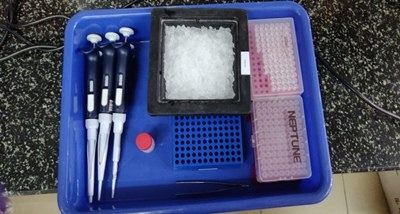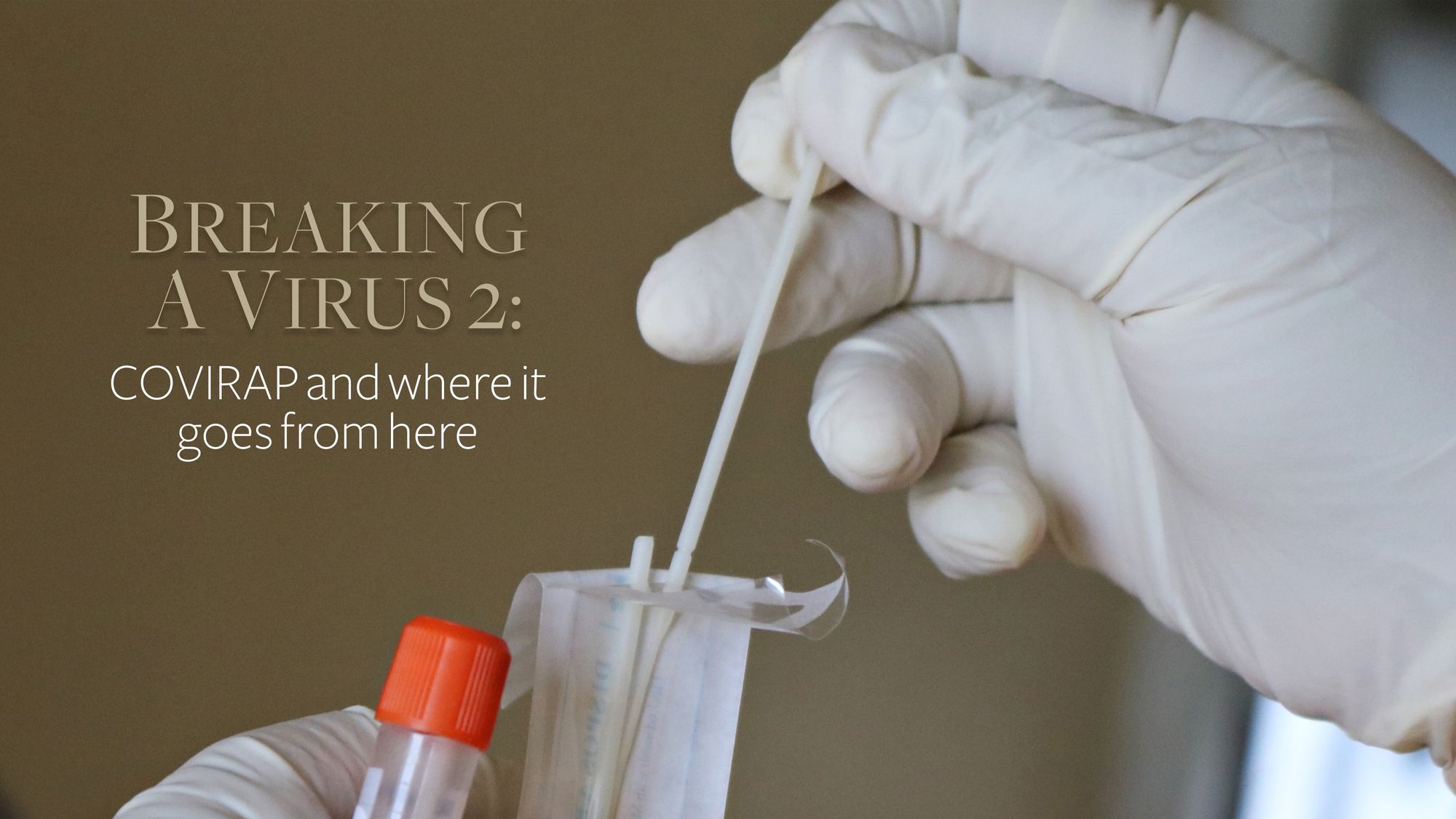Read part 1 and 2 of the article here: Breaking a virus: the story of IIT Kharagpur's ground-breaking COVID test
3
April-June 2020
All too often the students and researchers behind the scenes in science, don't get much credit. There may be a cursory mention and of course, the professional satisfaction of having contributed to a project of immense social value, at most. Not this time - this story involves the hard work of 3 research scholars at IIT Kharagpur, during the height of the uncertainty gripping pandemic-hit India. We spoke with them:
Sujay Biswas - Research Scholar at SMST, IIT KGP
Nandita Kedia (NK)- Research Scholar at School of Bioscience, IIT KGP
Saptarshi Banerjee (SB)- Research Scholar at School of Bioscience, IIT KGP
Q. Sujay, you have perhaps the most unique background here - can you tell us a little about how you came into this interdisciplinary field?
Sujay Biswas: IIT Kharagpur's unique forays into Medical Science had influenced me when I was completing my MTech. in Mechanical Engineering here. So despite my background working in Microfluidics, I developed an interest in medical diagnostics. I worked with Tata Steel for 7 and a half years, but then that curiosity pulled me back here for a PhD at the School of Medical Science in 2016. I knew almost nothing about the medical field! But the school was very supportive and allowed me to catch up, and soon I was able to apply my unique expertise and become an asset.
Q. Nandita and Saptarshi, you've been the Biological researchers at the core of this project, before it got fast tracked into a Covid diagnostic device. How has the journey been?
Nandita Kedia: Saptarshi and I have been doctorate students under Professor Mondal since 2017, so Virology is our cup of tea. We have been working on the biological protocol, but the absolute urgency of the situation and the pressure that something that we've theoretically proven has to work, and the whole country is depending on work like ours, was a very different situation.
Saptarshi Banerjee: Yes, exactly. Along with the urgency, we also had to deal with the new challenge of robust and minimal processes, since we wanted to make a device that did not depend on the sophisticated and usually inaccessible infrastructure we have in our labs. How and whether this protocol will scale to an industrial level has kept us up at night. We have been working with artificially synthesised DNA of about 1 kb (kilo base pairs), but the actual CoV-2 virus has a genome of ~30 kb.
Q. While the life of a researcher is something all of you have grown into, how difficult was it to continue this vital research in the middle of a pandemic?
SB: For starters, most people left campus for their homes to be with family. We knew we were working on something with huge social importance, so we just couldn't bring ourselves to leave, and stayed on.
NK: The biggest problem that caused is that there weren't many competent researchers left. Since our group is small, Saptarshi and I were the only students working on this project day and night. It was all going fine until...
SB: ...The fire! Due to an electrical malfunction, our department caught fire, destroying much of our samples and records. We had to start from scratch, cleaning up and making all of them again. It was really challenging.
Sujay: My challenges were a little different... because I am married and had to care for a 15 month old daughter too! (laughs) Spending 4 months in the lab and barely any time at home was tough, like Nandita said. But working with someone like Prof SC is inspiring and you are very motivated to deliver.
NK: If I can add on to that, one thing that drove us on throughout was the thought that, even though we understood the virus and other aspects of the pandemic well, unlike doctors or health workers, we could not help directly - and so we HAD to do this, to contribute the best way we could.
Q. What was the experience like of working with such an interdisciplinary team, focused on one goal?
Sujay: From my previous experience developing medical diagnostics (glucose, blood tests etc.), I knew how crucial it is to have experts from several fields, and a very good team collaboration - it is very necessary when bringing technology to a previously untouched field. I have been glad to find a very conducive environment for this here in KGP - students from the Electronics Department helped us to develop the app; we had the advice of medical experts helping us; and Prof Aditya Bandopadhyay and his students from the Mechanical Department played an invaluable role in helping build this revolutionary device.
4
July - October 2020
The months ahead were arguably the most important for the team - the litmus test for whether their diagnostic device - newly christened 'COVIRAP' - could deliver a huge change to Covid-19 testing, in India and worldwide.
First, on the medical side. As per ICMR (Indian Council of Medical Research) guidelines, the prototype that was made had to be converted into a field-ready test kit, to be implemented in identified testing centres.
The real world is no sanitised laboratory. These clinical trials - first on a smaller scale, then expanded - would really put the team's work to tas . Whether the robustness and simplicity of the technology holds up against the harsh conditions of the field. Crucially, this was the first time the testing kit would be used on real-life samples from patients.
Testing
In a launch event on 21st October 2020, hosted jointly by IIT Kharagpur and the ICMR National Institute of Cholera and Enteric Diseases (NICED), the lead collaborators Dr Shanta Dutta and Dr Mamta Chawla Sarkar, lifted the curtain on the crucial testing that had happened over the past few months. The total number of RNA samples extracted from patients numbered 200. Using the standard RT-PCR test, it was predetermined that out of the 200, there were 115 positive and 85 negative samples. The results were encouraging:
The positive percentage agreement (PPA), i.e the percentage of samples that were correctly determined to be positive, was at 94%. This is extremely encouraging, as PPA determines the sensitivity of a test - how sensitive it is to the viral load (CT) in the sample. Low sensitivity implies a higher viral load is needed, which isn't always ideal in the real world, since there could be many patients with relatively mild infections that pass undetected, which can then rapidly worsen or be transmitted unknowingly to a more vulnerable person. As expected, with a lower CT value of 30 and below (low CT -> high viral load), the PPA rapidly rose to nearly 99%!
Meanwhile negative percentage agreement (you guessed it, the percentage of samples correctly identified as negative) was higher at 98%. NPA has a very different implication however - it determines the specificity of a test. This is very different from sensitivity - negative tests have no viral load at all, duh! - since CT value does not play a role here. Instead, NPA gives us an idea of how specifically the test can detect the SARS-CoV 2 virus in particular, as opposed to other viruses. This is important in removing false positives - preventing patients who've probably just come down with a bad case of flu, from being branded Covid-positive, hence saving them a world of worry and state authorities plenty of resources. Specificity and Sensitivity are the two primary parameters for any diagnostic test.
The final verdict on the testing phase however, came from Dr Mamta Chawla Sarkar, the internationally acclaimed virologist who oversaw the patient trials on behalf of ICMR-NICED:
“A detailed scrutiny of the testing results has clearly shown that this assay holds the capability of detecting extremely low levels of viral loads that any other method based on similar principles of testing, even those from the most celebrated research groups across the world, could not come up with so far. In practice, this means that very early stages of infection can be detected, thereby isolating the patient and arresting the uncontrolled spread of infection in the community via asymptomatic patients.”

ICMR Certification
After the successful round of testing, the ICMR-NICED finally bestowed their coveted certification to the COVIRAP test kit.
Dr Shanta Dutta, the Director of ICMR-NICED was effusive in her praise, following the testing and validation phase that she oversaw. " I was very impressed with the portable low-cost machine unit that can truly be a game-changer for COVID-19 diagnostics at peripheral laboratories with the support of unskilled human resources as operators", she said. She also pledged the support of ICMR-NICED in working with the team to further collaborate to improve the testing method in the future.
Barring the efficacy of the test itself, the innovative form factor and robust design that we discussed in Part 2 of the article, was appreciated too.
Since it is extremely user-friendly, the testing could be conducted by minimally trained rural youth, as opposed to clinicians or biologists who are in short supply.
To simulate the kind of rural environment the test will need to work in, the team set up an experimental model mimicking a remote location with limited resources. The test kits were transported by road for several hours, and then stored in a normal refrigerator at 4ºC overnight before performing the test the next day; it worked just fine.
The path forward
Creating a disruptive product requires seamless operation at scale. And this is where Prof. Chakraborty stresses the importance of the technology they've created.
"We are in close contact with government agencies like the ICMR - as well as in touch with the biggest pharma and manufacturing companies in India, who have expressed interest after we filed our patent for the device" he said.
When I ask about whether the team would prefer working with the govt. or with private industry moving forward, he has an interesting answer:
"No technology for the benefit of the public can be fully disseminated fairly, in an accessible model, without state involvement. At the same time, no disruptive and efficient business model can be developed without working with industry partners and entrepreneurs".
The news of the device has created ripples in the month ever since the launch of the prototype itself, on the 25th of July. Worldwide, universities, diagnostic companies and alumni in industry have paid notice. With respect to this Rapid Covid Diagnostic Test, there is everything to play for and a limitless potential for impact. "We see great adoption of this device in the rural areas of India and other developing countries, where just a single device costing Rs.5000 (An RT-PCR machine costs about 15 lakh rupees) would be able to test hundreds of people every day". When viewed in the context of a single RT-PCR Covid test costing around Rs. 4500 in cities, it is absolutely phenomenal that a single test by this device would be much less. This is disruption at the highest level.
But both Prof Mondal and Prof Chakraborty, have their respective visions that extend beyond our current crisis. Ways of thinking and conducting research that will have an impact much after the last positive Coronavirus case.
Arindam Mondal looks at disease testing for viruses, and sees a hopelessly muddled story. If you exhibit symptom A, common to Diseases X, Y and Z, more often than not you are going to have to undergo THREE separate tests, just to confirm which one you have - which may not even be the correct diagnosis!
He correctly sees a future where diagnostics are a rapid and efficient tool to Medicine, not the most cumbersome and expensive step in an already convoluted process. In line with this, the Molecular Virology team plans to extend this protocol to create a single test kit that can be used to detect and rule out several RNA viruses. For example, a 'Respiratory Disease Toolkit' where the swab sample is tested against 2 or 3 probes that do not cross-react - Influenza, Parainfluenza, Rhinovirus, Coronavirus. Something that could be game-changing and bring the much needed reforms to medicine that medical science has always promised.
Professor Suman Chakraborty is looking at an even higher horizon. "Where do new ideas in emerging fields come from? The iPhone with computing and electronics; Medical diagnostics with biologists and engineers; Those ideas are inherently interdisciplinary. The very idea that we have research fixed to specific disciplines, and so-called 'interdisciplinary' research is glorified, should be abolished." All research is interdisciplinary, and it should be! A revolutionary idea, but one that is quickly gaining credence in all top universities in the world.
However, he strongly feels that any attempt to enforce 'interdisciplinary thinking' forcefully, would just lead to failure. At best, a simulacrum of status quo where students are fed their research topics and careers by buzzwords.
"Collaborations like ours, between a mechanical engineering lab and biological science, are so uncommon in India because a stigma still exists. Mechanical Engineers are polarised to think they 'hate' biology; Traditional Biologists still shy away from hard maths and engineering. It's very clear that interdisciplinary thinking needs to percolate to the student level, to inspire them to cook up these ideas themselves." he explains.
The way to fix this stigma he feels, is to create more fascinating examples; for Academic Researchers to practice what they preach. Instead of perpetuating the rat-race for increasingly niche papers in search of coveted tenure, to strive to create high-impact research with a social benefit.
College professors are sometimes dismissed as dinosaurs, out of touch with the generation they teach. Prof SC however, leaves me with an incisive observation: "You cannot try to enforce a culture, however good and necessary you think it is. There will always be a natural tendency to overrule it. The change you want to create has to be organic and from the grassroots".
While we students are all very far from the grand IIT KGP Main Building, the fiery red letters that are emblazoned on its facade are firmly imprinted in our minds: Dedicated to the Service of the Nation.
It is in line with these goals that a project like this assumes immense importance as a standard to hold up. There is often a ridiculous notion that research that is geared to creating low-cost and frugal solutions is 'jugaad' or MacGyvered into a barely standing, sub-standard result. Nothing could be further from the truth.
It is the ultimate goal of all Engineering and Science to create high value solutions that are not high cost. Diagnosing Covid by analysing the coronavirus' genetic material is no big deal - it's a technique from decades ago. Doing so at Rs. 400 per test? ($5.3) That's using cutting edge collaboration - conceptualised in a little meeting room months ago, and worked on day and night by researchers, in the middle of a global pandemic - to create a truly disruptive low-cost technology.


